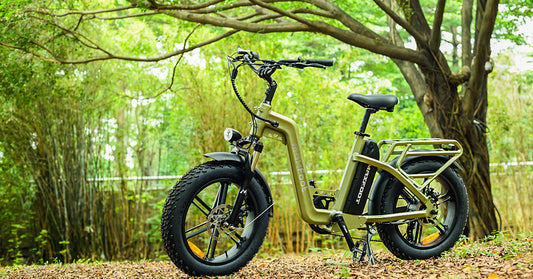Imagine a quiet, early morning walk in your neighborhood park. The tranquility only disturbed by occasional bird songs and the soft rustling of leaves. Suddenly, there's a soft humming sound, growing louder and then fading away. A sudden glance reveals the source - an electric bike zooming past.
The incident sparks curiosity - how noisy are electric bikes? Let's delve into the world of e-bikes and their noise levels to unravel this enigma.
Are Electric Bikes Loud?
In general, e-bikes are designed to be significantly quieter than their combustion-engine counterparts. Most of the noise produced by an electric bike comes from the electric motor, gears, and the tires' contact with the road. However, compared to the rumble of a traditional motorcycle, this noise is relatively low.
When quantifying the noise levels of motorbikes versus electric bikes, it's revealing to consider the decibel (dB) measurements. A standard motorbike usually generates a noise level ranging from 80 to 100 dB. Contrastingly, electric bikes typically emit a significantly lower noise level, between 50 to 70 dB.
To put these figures into perspective, consider that the sound level of a normal conversation typically measures around 60 dB. Hence, most e-bikes produce noise levels on par with, or just slightly above, everyday conversation levels.
Furthermore, according to the U.S. Environmental Protection Agency (EPA), noise levels below 70 dB are generally considered safe for prolonged exposure, falling within acceptable sound pollution standards. This highlights another advantage of electric bikes; they are not only quieter in comparison to traditional motorbikes but also align with environmental noise guidelines, contributing to a healthier, less noisy environment.
The Source of the Sound: Motors and More
Electric bikes are pedal bicycles with integrated electric motors that can be utilized for propulsion. Their noise production can vary depending on numerous factors including the quality of the bike, the terrain, and the type of motor used.
The Role of Electric Motors
The electric motor is the heart of the e-bike, responsible for the added propulsion that distinguishes it from traditional bicycles. In operation, it emits a gentle hum or whir, a far cry from the harsh exhaust note of a gas engine. This is because electric motors generate power through magnetism, a process that is inherently quieter than the explosive combustion process in conventional engines. This relative silence is a key aspect of electric bikes that makes them an appealing alternative for those seeking a less intrusive, more serene commuting experience.
Hub Motors versus Mid-Drive Motors
The type of motor used in the e-bike also plays a role in determining the noise level. Two commonly used types are hub motors and mid-drive motors. Hub motors are quieter, but they can emit a faint whirring sound when the bike is in motion.
On the other hand, mid-drive motors, which provide power directly to the bike's chain, may produce slightly more noise due to the involvement of more moving parts.
Gearing Mechanism
Next in line are the gears. Electric bikes, particularly those equipped with mid-drive motors, employ a complex system of gears for power transmission. When these gears are engaged during a ride, they tend to produce a soft mechanical sound. Again, the noise is fairly muted, akin to a whisper rather than a shout, and becomes even less perceptible as the rider acclimates to the sound.
Influence of Speed and Terrain
Riding at higher speeds may also increase the noise emitted by an e-bike, as both the motor and gears work harder and create more noise. Similarly, the terrain plays a critical role in the noise output. Smooth, paved roads allow for quiet operation, while bumpy, off-road trails may cause the bike to generate more noise due to increased friction and vibration.
Build Quality and Tire Noise
A bike's overall build quality also contributes to its noise output. Higher-end e-bikes typically have better noise insulation and superior build quality, which reduces the sound produced by the motor and moving parts. Cheaper models might lack these features and therefore could be noisier.
Tire noise, or the sound created by tires rolling on the pavement, is another source of sound from e-bikes. Wide, heavy-duty tires tend to generate more noise than narrower, smoother ones.
Addressing Safety Concerns
One common misconception is that silent e-bikes pose a safety risk because pedestrians cannot hear them coming. While it's true that quieter bikes might be less noticeable, this doesn't necessarily translate into greater danger. E-bikes, like all vehicles, should be ridden responsibly, respecting speed limits and paying attention to their surroundings.
Additionally, some e-bikes come with artificial sound systems that create noise to alert pedestrians of their approach, which further mitigates any potential safety concerns.
Final Words
To sum it up, the noise level of an electric bike is generally low, and under most conditions, e-bikes are much quieter than cars and motorcycles. Although certain factors such as motor type, build quality, speed, terrain, and tire type can cause variations, these sounds tend to blend into the background noise of everyday life.
In the quiet of the early morning, the soft hum of an e-bike signifies not an intrusion, but the gentle progression towards a quieter, greener future.




